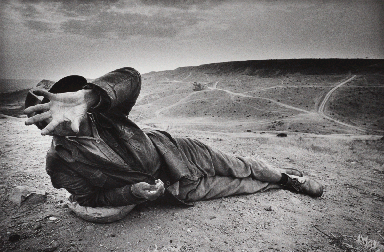Thought-Provoking Photography Show Opens at Princeton University Art Museum


“EL MIGRANTE:” Elsa Medina is considered among the best of Mexico’s photojournalists. Besides reporting on Guatemala, Haiti, and Nicaragua, she has recorded the plight of Mexicans crossing the border into the United States. The photograph shown here was taken in the dry dusty desert of Cañon Zapata, Tijuana, in 1987. A 2011 gelatin silver print, it is on view as part of the exhibition, “The Itinerant Languages of Photography,” currently on view at the Princeton University Art Museum. For more information, call (609) 258-3767, or visit: www.artmuseum.princeton.edu
(Courtesy of the Artist)
With a camera in every cell phone and a cell phone in practically every pocket, photographs are no longer what they used to be. An individual image can take on a life of its own as it travels beyond the traditional photo album to all corners and cultures of the world. The meaning of the photographic images in relation to changing context is examined in a new exhibition that opened Saturday at the Princeton University Art Museum.
“The Itinerant Languages of Photography,” traces historical modes of photographic itinerancy from its origins in the 19th century as a shifting archival record to its conceptualist manifestations in the present.
On view are rare black and white photographs by masters as well as lesser known and emerging photographers: Henri Cartier-Bresson, Paul Strand, Marc Ferrez, Manuel and Lola Alvarez Bravo, Joan Colom, Graciela Iturbide, Susan Meiselas, Pablo Ortiz Monasterio, Joan Fontcuberta, and Rosângela Rennó.
“This exhibition asks us to consider the photograph as a globally transmitted, continually translated and annotated document — reinterpreted and re-animated through the lens of our shared histories, memories, and experiences,” said Princeton University Art Museum Director James Steward.
The image that opens the show is a “Googlegram” by the Catalan photographer Joan Fontcuberta who was born in 1955. Titled Niépce, the work takes inspiration from the earliest-known photograph, View from the Window at Le Gras, by Joseph Nicéphore Niépce, circa 1826. Mr. Fontcuberta created his tribute by processing the results of a Google image search for the words “photo” and “foto” through photomosaic software.
The result is a huge composite comprised of some ten thousand pieces from all over the world that brings the past and the present together and sets the stage for rest of the exhibition, which is arranged in four sections. The dizzying artwork suggests that every image is laced with multiple connotations.
Mr. Fontcuberta received the prestigious Hasselblad Award this year and will deliver the keynote address at a symposium on Thursday, November 21, from 6 to 7:30 p.m.
The show’s first section, “Itinerant Photographs,” features work from two Brazilian collections, one assembled between 1891 and 1925 and held in the National Library of Brazil, and the other from a similarly early collection of work by the itinerant photographer Marc Ferrez and others.
The second, “Itinerant Revolutions,” presents several modernist photographers working during and after the Mexican Revolution (1910-1920), including locals Manuel and Lola Alvarez Bravo as well as pieces by Tina Modotti, Henri Cartier-Bresson, and Paul Strand.
Don’t miss Hugo Brehme’s portrait of Emiliano Zapata and his marvelous mustache with his sash and sword; Gracielo Iturbide’s cemetery with flocking birds; the iconic image of Adelita the Soldadera; and photojournalist Enrique Metinides’s sorrowful images among others depicting mourning mothers, murdered men, and dead children.
Almost all of the photographs in this small show of some 90 works from public and private collections in Argentina, Brazil, Mexico, Spain, and the United States, are black and white. The exhibition is detailed and well-presented, informative and thought-provoking. Curators Eduardo Cadava, of the department of English, and Gabriela Nouzeilles, of the department of Spanish and Portuguese languages and cultures, offer a privileged look at this material and have authored an illustrated 240-page catalogue that includes an essay by Mr. Fontcuberta.
The third section, “Itinerant Subjects,” examines ways in which photography approaches moving subjects with scenes from the streets of Spain and Latin America. Here is the work of street photographer Joan Colom and surrealistic photo-essays by Mexican photojournalist Nacho López as well as work by Eduardo Gil, Graciela Iturbide, Elsa Medina, Susan Meiselas, and Pedro Meyer.
“Itinerant Archives,” the last section of the exhibition, explores ways in which photographs are used and reused, quoted and revitalized. The highlight here is a stunning piece that is an aerial perspective of a crowd, “Multiples: it is us (people),” by Cassio Vasoncellos. Everyone is wearing a hat and the effect evokes an organic form like moss or lichen.
Highlights include Marcelo Brodsky’s The Undershirt / La Camiseta, shot in 1979 and reprinted in 2012; Joan Colom’s Fiesta Mayor, 1960; and Manuel Alvarez Bravo’s Striking Worker, Assassinated (Obrero en Huelga, Asesinado), 1934.
According to a press release, “Latin America has been at the forefront of the development of new aesthetic paradigms in modern and contemporary photography and the exhibition calls attention to “significant but often neglected histories of photography beyond the dominant European and American canon.”
The digital revolution has created an explosion in the production, circulation, and reception of photographic images. Attending this exhibition brings fresh perspective to the activity of taking and/or making photographs.
“The Itinerant Languages of Photography” is on view at the Princeton University Art Museum through January 19. For more information, call (609) 258-3767, or visit: www.artmuseum.princeton.edu.

